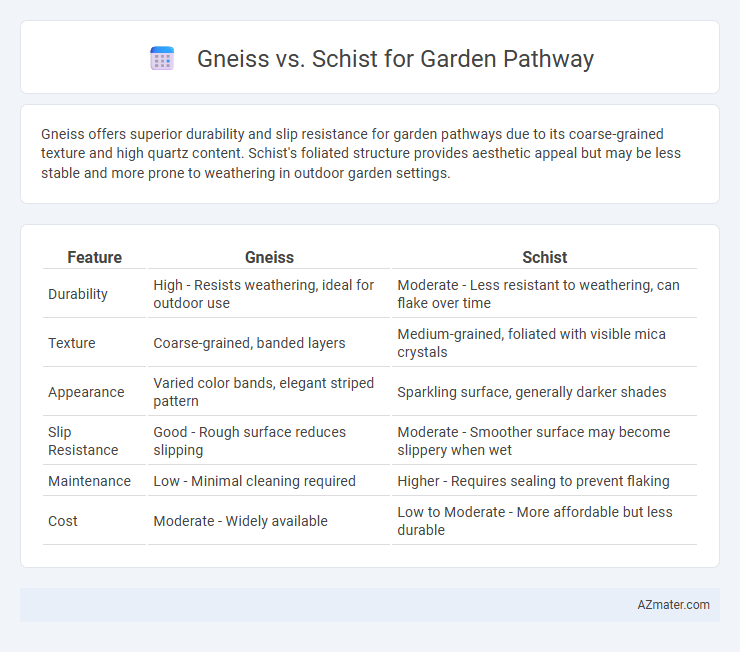Gneiss offers superior durability and slip resistance for garden pathways due to its coarse-grained texture and high quartz content. Schist's foliated structure provides aesthetic appeal but may be less stable and more prone to weathering in outdoor garden settings.
Table of Comparison
| Feature | Gneiss | Schist |
|---|---|---|
| Durability | High - Resists weathering, ideal for outdoor use | Moderate - Less resistant to weathering, can flake over time |
| Texture | Coarse-grained, banded layers | Medium-grained, foliated with visible mica crystals |
| Appearance | Varied color bands, elegant striped pattern | Sparkling surface, generally darker shades |
| Slip Resistance | Good - Rough surface reduces slipping | Moderate - Smoother surface may become slippery when wet |
| Maintenance | Low - Minimal cleaning required | Higher - Requires sealing to prevent flaking |
| Cost | Moderate - Widely available | Low to Moderate - More affordable but less durable |
Introduction: Gneiss vs Schist for Garden Pathways
Gneiss and schist are both metamorphic rocks commonly used for garden pathways, each offering distinct texture and durability. Gneiss features a banded or foliated appearance with coarse grains, providing a resilient surface ideal for heavy foot traffic. Schist, with its layered and flaky structure, offers a more decorative, natural look but may require more maintenance due to its tendency to split along mineral layers.
Geological Origins of Gneiss and Schist
Gneiss and schist both originate from metamorphic processes but differ in their geological formation. Gneiss forms under high-temperature and high-pressure conditions resulting in a coarse, banded structure due to the segregation of mineral types like quartz, feldspar, and mica. Schist develops under moderate to high pressure with abundant platy minerals such as mica, giving it a foliated texture that influences its durability and surface appearance in garden pathways.
Physical Appearance and Texture Comparison
Gneiss features a banded or foliated appearance with alternating light and dark mineral layers, giving it a visually striking and coarse texture ideal for garden pathways that require a natural, rugged look. Schist, on the other hand, exhibits a more pronounced flaky or plate-like texture due to abundant mica content, offering a shinier, layered surface that can create a reflective and decorative effect in landscape designs. The choice between gneiss and schist depends on desired aesthetic contrast and slip resistance, with gneiss providing a sturdier, rougher surface and schist lending a smoother, more polished appearance.
Durability and Weather Resistance
Gneiss offers superior durability and weather resistance for garden pathways, characterized by its coarse-grained texture and high quartz content that withstands heavy foot traffic and harsh weather conditions. Schist, while aesthetically appealing with its foliated layers and mineral variety, tends to be less durable due to its tendency to split along foliation planes, making it more susceptible to weathering and erosion. Choosing gneiss ensures a longer-lasting pathway that maintains structural integrity against moisture, freeze-thaw cycles, and UV exposure.
Slip Resistance and Safety in Garden Paths
Gneiss offers superior slip resistance for garden pathways due to its coarse texture and interlocking mineral grains, providing enhanced safety during wet conditions. Schist's foliated structure can create smoother surfaces that may become slippery when wet, posing a higher risk for slips and falls. Choosing gneiss ensures a safer, more secure footing in garden paths where moisture and organic debris are common.
Installation Process for Gneiss and Schist Pathways
Gneiss pathways require careful alignment of their foliated layers during installation to ensure stability and a uniform surface, often involving cutting large slabs to fit the desired pathway dimensions. Schist pathways demand meticulous handling due to their flaky texture, typically necessitating multiple layers of smaller stone pieces for added durability and slip resistance. Both materials benefit from a compacted gravel base and proper edging to maintain long-term integrity and prevent shifting.
Maintenance Requirements and Longevity
Gneiss offers superior durability and low maintenance requirements for garden pathways due to its coarse-grained composition and resistance to weathering, making it ideal for long-term outdoor use. Schist, with its foliated texture and layered structure, requires more frequent maintenance to prevent flaking and erosion, potentially reducing its lifespan in garden pathways exposed to heavy foot traffic or harsh conditions. Choosing gneiss ensures a more resilient and long-lasting pathway with minimal upkeep compared to schist.
Cost Analysis: Gneiss vs Schist
Gneiss generally costs more than schist for garden pathways due to its higher density and durability, leading to longer-lasting installations that may reduce maintenance expenses. Schist offers a cost-effective alternative with easier installation and natural slip resistance, although it might require more frequent upkeep in high-traffic areas. Evaluating total cost of ownership, including material price, labor, and maintenance, is crucial when choosing between gneiss and schist for durable, attractive garden pathways.
Aesthetic Appeal and Landscaping Design Considerations
Gneiss offers a striking banded appearance with contrasting mineral layers that create a sophisticated and natural look, ideal for elegant garden pathways emphasizing texture and color variation. Schist provides a foliated, flaky texture with shimmering mica content, adding a rustic and organic aesthetic that complements informal, woodland, or naturalistic landscaping designs. Both stones differ in durability and slip resistance, with gneiss generally being harder and more suitable for high-traffic areas, while schist's softer, layered structure requires careful sealing and placement to maintain its beauty and functionality.
Eco-Friendliness and Sustainability Factors
Gneiss and schist both offer eco-friendly options for garden pathways, with gneiss being more durable and resistant to weathering, reducing the need for frequent replacement and waste generation. Schist's foliated texture allows better water permeability, promoting natural drainage and minimizing soil erosion, enhancing sustainability in garden design. Sourcing locally quarried gneiss or schist further decreases transportation emissions, supporting sustainable landscaping practices.

Infographic: Gneiss vs Schist for Garden pathway
 azmater.com
azmater.com